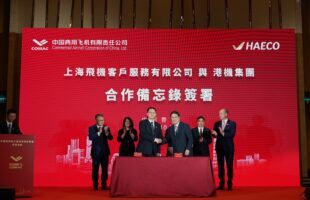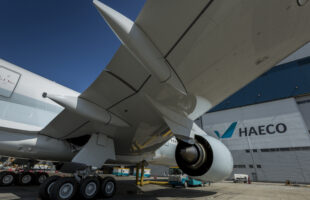

HAECO announced in early September that its newly formed commercial division is now up and running. Four regional commercial teams are now in place in Asia Pacific, China, EMEA (or Europe, Middle East and Africa) and the Americas, who will market and sell the company’s full range of products and services covering air frames, cabin, components and engines.
Completing the list of commercial vice presidents to lead the different regions is Klaus-Peter Leinauer, who will be in charge of EMEA. Klaus, who got his qualification as a private pilot at the age of 14 and spent most of his career in aviation, says there is currently more demand to avoid complex and costly engine overhauls by managing work scopes on a modular level.
In an email interview, Payload Asia talks to Klaus as he shares his prospects for the EMEA region, the market trends that will drive the demand for HAECO’s services, as well as the group’s future plans, including enhancing its capabilities on narrow-body platforms.
Can you give us a brief background of your work experience? Was there any backstory that led you to pursue a career in the aviation and air cargo industry, and where do you attribute your success?
I have been working in aviation for more than 20 years now. Even if not always easy, I have never regretted working in the aviation sector. Even in my personal life I spend quite some time in aviation, including being a qualified private pilot since the age of fourteen. In order to achieve a successful career in aviation, I see two important aspects: first, an appropriate education and secondly an enthusiasm for lifelong learning.
What would be the first order of business in your new role? What are your prospects for the EMEA region?
Working under HAECO Group Chief Commercial Officer Richard Kendall’s leadership, my team and I will follow the Group’s business strategy based on two pillars. First, we will draw on the existing customer relationships in the EMEA region and make sure that we continue to provide quality services and solutions to those customers. Second, we will increase the visibility of HAECO Group as a leading aviation product and service provider to other airlines and aviation entities in the region. Our excellent market reputation, the comprehensive service and solution portfolio that we provide and our professional and motivated people will help us in implementing the vision in the regions for which I am responsible.
What are the key trends that would drive the demand for your division’s services in that part of the globe? Is there a particular country or region that you are looking to focus on from the get-go?
There are different trends, partly also driven by the necessity for change due to the pandemic. One trend is that the services being asked for are more related to the overall economic situation in the industry. For example, there is currently more demand to avoid complex and costly engine overhauls by managing work scopes rather on a modular level than sending an engine into full overhaul. Additionally, we are seeing demand for services related to bringing aircraft out of storage. In general airlines are keen to win back their passengers, particularly their premium passengers, when the pandemic situation becomes more stable and may therefore modify their cabin layouts. We at HAECO can offer both cabin interior products and the modification services and installation of these products.
Do you expect the new commercial team to benefit in correlation with growing demand for freighter conversions? What would be the strategy to ensure that air frames, components and engines can be easily accessible whether you’re in Europe, the Middle East or Africa?
Passenger-to-Freighter (P2F) conversion has always been an important market and even more important now as demand on dedicated airfreight has increased with the reduction in passenger aircraft belly space since the beginning of the pandemic. We at HAECO have substantial experience and capability to conduct P2F conversions at our facilities in the Chinese mainland and in the United States.
As for making sure that all our services are available in Europe, Middle East and Africa, our strategy is relatively straightforward. For components and engines, it does not make a big difference where our customers are located as this is very much a global business. The equation is slightly different for components such as landing gear or large components such as thrust reversers. However, if an overhaul of a landing gear or thrust reverser can be planned to coincide with the ground-time of a base maintenance layover at our facilities, we do have extensive back-shop capabilities.
As for airframes, we currently focus on wide-body aircraft which we would send to one of our facilities in the Chinese mainland or Hong Kong. The fact that HAECO can provide one-stop-shop for services and solutions makes it attractive even for markets which are slightly further away, particularly if we combine some of those services into the ground time of an aircraft.
More locally within Europe we have recently established a facility for our Global Engine Support division which provides an opportunity where an operator needs flexible and cost optimised engine solutions.
From your knowledge, are there certain types of aircraft in EMEA that will see more demand and require more capacity? If so, what are they and how are you looking to fill the demand?
The capability list of HAECO shows already that we can serve almost every aircraft platform which is currently flying. There are certain trends in the air transport industry, with a few exceptions the very large aircraft such as the A380 or Boeing 747-400/-8 will be retired and be replaced by more flexible and more economical twinjet such as B777, B787 or A350. We in HAECO Group will therefore continue to develop solutions for these platforms and will increase our capabilities on narrow-body platforms in the future, not only in Europe, Middle East & Africa but also other parts of the world.









